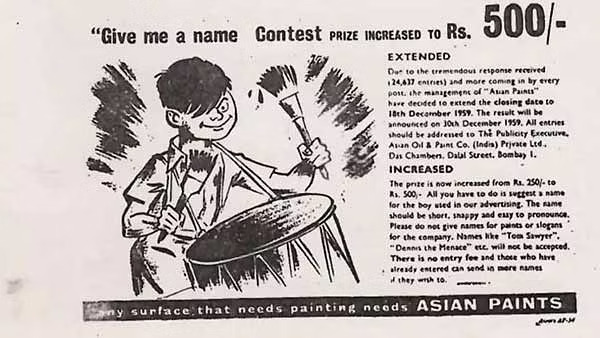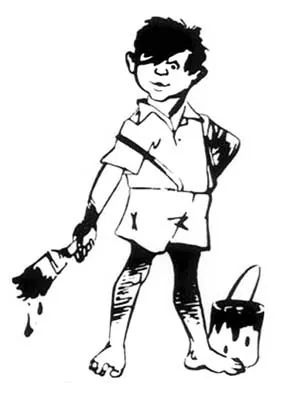Famous Brands – Asian Paints

From its humble beginnings, Asian Paints has become a true Indian multinational with resounding success across all markets.
Four Gujarati friends, Champaklal Choksey, Chimanlal Choksi, Suryakant Dani, and Arvind Vakil, founded Asian Paints in a garage, rented at Rs 75 per month in Gaiwadi, Girgaon, Mumbai. In February 1942, they established the business. Champaklal is often cited as the company’s primary visionary and co-founder.
The original name for Asian Paints was “The Asian Oil & Paint Company,” which was chosen at random from a phone book. And set up as a partnership.
After making INR 0.35 million in sales in 1945, the partnership was converted to a private limited company.
Wartime restrictions on paint imports limited competition to only Shalimar Paints and a few foreign firms during the Quit India Movement in 1942. Asian Paints rushed to fill this gap. In 1952, Asian Paints had 23 crores in yearly sales and a 2% PBT margin after taking over the market.
Making Space for Possibilities
Since Asian Paints had no preexisting distribution network, dealers in major cities initially ignored the company. Asian Paints kept trying, and they proceeded to Sangli, Maharashtra, to get a distributor in a rural location. They played on the psyche of these distributors, as they felt proud buying directly from a company in the city (they had to buy from dealers in big cities for other paints).
Asian Paints spotted unique opportunities too. Tamil Nadu celebrates Pongal, whereas Maharashtra honours Pola. The bull as a deity is celebrated during both celebrations. They adorn the horns of their bulls with colourful paint.
Champaklal Choksey decided to sell vibrant paints in 100-150 ml tins. Choksey also observed that bulls often bury their horns in muck, leading them to conclude that paint quality must be maintained to ensure durability. They introduce vivid new colours in 100-150 ml cans.
Lime (chuna) was found to be widely used as a paint. Lime discoloured quickly and clung to the fabric. It introduced a washable distemper that cost just a little more than lime. To bridge the gap between the less costly dry distemper that peeled easily and the more expensive plastic emulsions, the business introduced “washable distemper” in the 1950s. They used the slogan “Don’t lose your temper, use Tractor Distemper” to market their product.
Using a rudimentary coal furnace and hand-stirring, Asian Paints’ R&D department made a breakthrough in 1957 by creating a procedure for generating phenolic and maleic acid resins of worldwide grade. The same year, the firm also opened a factory in Bhandup, Mumbai, to meet the growing demand for paint in the city. In 1967, Asian Paints had already established itself as India’s preeminent paint producer.
Gattu

In 1954, the idea for the mascot was born. The legend says that while chain-smoking, R.K. Laxman was trying to come up with an image for the Asian Paints mascot. “…through the cloud of smoke, he saw the image of a little boy with a paintbrush take shape, and ‘Gattu’ mascot was born,” as the story goes.
The mascot’s form was complete, but it lacked a name. There was a “Give Me A Name” contest with a cash reward of Rs 500. The winners of the event were two Bombay residents who came up with the name Gattu and split the prize money among themselves
Over the years, Gattu has been portrayed in a variety of ways. In early advertising, for example, he is shown as a naughty youngster who insists on painting when he isn’t authorised to and on inappropriate surfaces (the bald head of a man). Any surface in need of paint required Asian Paints, and the slogan that accompanied him stayed constant.

Gattu and his paintbrush became synonymous with Asian Paints, and this was true even when the company switched advertising agencies to Ogilvy. Gattu was always there, even if it was only a cameo, in every single advertising campaign.
Before Piyush Pandey came up with the campaign Har Ghar Kuch Kehta Hai, Gattu performed an excellent job for Asian Paints. To read about the ad, visit:https://onlykutts.com/index.php/2021/07/06/asian-paints-har-ghar-kuch-kehta-hai/
Growing Up
The corporation also realised early on that it had to recruit top personnel and keep them for the long haul if it was to succeed. It desired to achieve success in the dynamic market. Asian Paints has filled positions with graduates of India’s most prestigious universities.
The business was also ahead of its time by purchasing India’s first mainframe computer in the early 1970s, proving its foresight in recognising the significance of computers. In the past, demand forecasting helped the firm streamline its supply chain.
The Tussle
The families of the company’s four founders, Champaklal Choksey, Chimanlal Choksi, Suryakant Dani, and Arvind Vakil, handled business amicably up until the 1990s.
As the corporation grew outside India, however, disagreements surfaced in the 1990s. When Champaklal passed away in July 1997 and his son Atul became CEO, things quickly escalated. Since he was pessimistic about the company’s long-term prospects, he opted to leave. After DSP-Merrill Lynch attempted to broker a transaction with Morgan Stanley and Capital International, the two international institutional investors backed out, claiming they had been misled about the identities of the stockholders they would be purchasing the stocks from.
Now, Choksey negotiated a two-stage deal with ICI Plc, a giant British paints and chemicals group that was lagging in fourth place in the country’s fast-growing market and was looking for ways to increase its share. The deal would see Choksey and his associates sell their 9.1% stake in the company for a consideration of Rs 128.70 crore, while his family would retain a much smaller 0.4% stake.
First, in August 1997, he parted ways with the company and sold his interests to Kotak Mahindra Capital Company (KMCC), the broker in the transaction. KMCC used a loan from ICI to purchase the shares for Rs 347.50 apiece. Then, KMCC sold the shares to ICI.
The other three promoters of the firm held more than 30%, so ICI’s purchase of 9% ownership was useless to them. They rapidly put up barriers, the first being an agreement prohibiting the sale of any shares to other parties. In a statement released on August 21, 1997, the newly appointed chairman of the business, Ashwin Choksi, referred to ICI’s action as “an attempt by a multinational rival to acquire a foothold in the company.” He also cited regulations set out by the Foreign Investment Promotion Board (FIPB) that required the backing of a company’s board of directors before government permission could be given to foreign investors. Vice Chairman Ashwin Dani made the official announcement that the business will not be selling any of its stock to KMCC.
ICI was not interested in engaging in a drawn-out conflict that might end up being physically damaging. After cancelling the transaction and waiting a few months, Kotak sold half of its shares to Unit Trust of India and the other half to the Choksi, Vakil, and Dani families, respectively.
Six years later, in October 2003, Asian Paints emerged as the top bidder to purchase the government’s 9.2 % stake in ICI, which it was selling as part of its disinvestment activities, adding an intriguing twist to the Asian Paints narrative. It was amusingly the same amount of shares that ICI had originally purchased in Asian Paints.
Several years later, Asian Paints dumped its ICI stock.
Success
Asian Paints is the only business in the world that has sustained a 20% annual growth rate in sales from 1952 to 2020.
- Since its IPO in 1982, shareholders have seen a return of almost 1800%.
- Over the previous 30 years, they have seen a doubling of their company size every three years.
In no other industry in India do we see:
- There is no middleman between the producer and the retailer.
- The store is restocked many times a day (four times a day, and twenty-eight times a week).
- Asian Paints, the company making the paint, makes 97% of the suggested retail price (MRP) [other goods channels contribute 30%–40% of MRP].
- No other competitor comes close to matching the distribution logistics. Seventy thousand merchants get paint shipments three million times a day.
- Berger Paints India, the No. 2 player, delivers 40,000 times per day, while AkzoNobel, the No. 3 company, provides 10,000 times per day.
Reference
https://en.wikipedia.org/wiki/Asian_Paints
https://startuptalky.com/asian-paints-case-study/#Startup_Story_and_History_of_Asian_Paints
https://www.cnbctv18.com/retail/backstory-the-battle-royal-between-asian-paints-and-ici-13351852.htm
https://theprint.in/feature/gattu-the-mischievous-asian-paints-mascot-who-ruled-indian-hearts-for-over-50-years/481697/: Famous Brands – Asian Paintshttps://www.thetechnicalera.com/post/born-of-asian-paints-and-rise-of-champaklal-choksey
https://therepresentative.co.in/the-unheard-secrets-behind-the-success-of-a-game-changing-indian-company-asian-paints/: Famous Brands – Asian Paints


